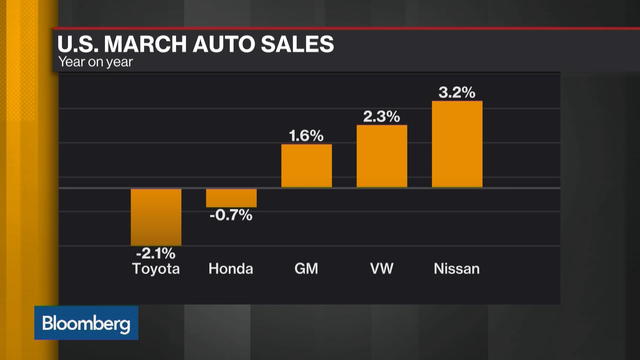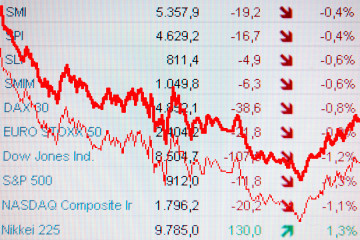U.S. Car Demand Collapse Jeopardizes Trump’s Auto Factory Push

published Apr 4th 2017, 7:52 am, by David Welch and Jamie Butters
(Bloomberg) —
Ford Fusion: down 37 percent. Chevrolet Malibu: down 36 percent. Toyota Prius: down 29 percent.
As those grim numbers suggest, the U.S. auto industry was blindsided last month by just how fast sedans have fallen out of favor with Americans now embracing roomier sport utility vehicles. Family-friendly crossovers may be more profitable, but the quick shift is causing headaches.
The swerve in consumer taste is just one of the forces — along with slumping used-car values and a pullback in subprime auto lending — that are changing the equation for manufacturers as President Donald Trump leans on the industry to build new plants and boost hiring. That’ll be hard to pull off: A glut of both new and used vehicles on the market has sparked an incentives battle, meaning new production lines are the last thing the companies need.
Industrywide deliveries in March were supposed to show a rebound following small dips in January and February. But the annualized sales pace, adjusted for seasonal trends, slowed to 16.6 million vehicles, from 16.7 million a year earlier, according to researcher Autodata Corp. Analysts RBC Capital Markets, wrote in a report Monday. had projected the rate would accelerate to about 17.2 million.
Automakers set a record in the U.S. last year, with 17.6 million vehicles sold.
“I’ve been expecting a slowdown for a while,” said Morningstar Inc. analyst David Whiston. “It shouldn’t be a surprise. Once you hit peak sales, it seems like you only have bad news ahead.”
Ample discounts have failed to spur demand for models like General Motors Co.’s Chevrolet Malibu and Ford Motor Co.’s Fusion, which are being surpassed by crossovers as the new American family vehicle of choice. The Toyota Prius sedan model continued its slump despite a thorough makeover in late 2015 that improved the staid hybrid’s ride.
Crossover Sales
In March, sales of crossovers including the Chevrolet Equinox and Ford Escape were up 11 percent, while mid-size cars like the Fusion fell 16 percent, according to Woodcliff Lake, New Jersey-based Autodata.
SUVs are keeping profits afloat. Cheap gasoline and more efficient engines are allowing buyers to get into the bigger people-movers they love. With an average sticker price of more than $38,000, a truck or SUV costs about $10,000 more than the average car. The incentives needed to sell them amount to an 8.8 percent discount, compared with 11 percent for cars, according to Edmunds.com, an industry research firm.
The problem is that even popular SUVs need more and more incentives to keep sales moving.
“Higher incentives have pushed demand about as far as it can go,” Joe Spak, an auto analyst with RBC Capital Markets, wrote in a report Monday.
Share Declines
While the pace of overall auto sales is plenty for companies to make money, investors aren’t buying. The March figures hit carmakers hard, with GM falling 3.4 percent and Ford declining 1.7 percent on Monday. AutoNation Inc., the nation’s largest car dealer, dropped 3.4 percent.
The one U.S. automaker to see its shares rise was Tesla Inc., whose upcoming mass-market Model 3 sedan gives the company a shot a real growth. The electric-car maker’s market capitalization surged past Ford for the first time.
For the auto industry’s incumbents, inventories are high and incentives are at near-record levels. That’s prompting companies to spend more on discounts just to stay close to 2016’s record results. Jessica Caldwell, an analyst with Edmunds.com, said odds are slim the U.S. market finishes at last year’s level, particularly as interest rates start to rise and leasing growth stalls.
“Last year, it seemed like ‘Oh, there’s still probably room for it to grow, all the other metrics look good,”’ Caldwell said. “But this month it seems like things are pointing to a slowdown.”
No New Plants
While industry sales probably won’t fall by much — they’re down 1.5 percent through March — profits could slip as automakers cut production. Trump will have a hard time getting the new investment he’s been demanding, even with consumer confidence strong and unemployment low.
“You’re not going to see the U.S. get new plants,” Mark Wakefield, who heads the automotive practice for consulting firm Alix Partners, said by phone. “The market went from pull to push nine months ago. We don’t see it going upward from here.”
GM has already made cuts since late last year at passenger car plants in Michigan and Ohio, laying off more than 3,000 workers who build Chevy Cruze compacts and Impala sedans. Ford in January canceled plans to build a $1.6 billion factory in Mexico, after deciding it didn’t need to boost output of Focus compacts.
Wakefield projects sales will slip by about 300,000 units this year, as a typical cyclical decline of 15 percent to 20 percent begins.
“When it drops, it drops sharply,” he said. “It doesn’t fade down.”




No Comment